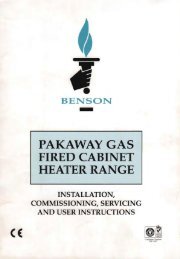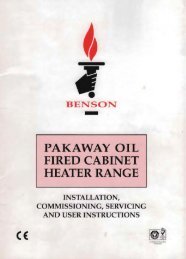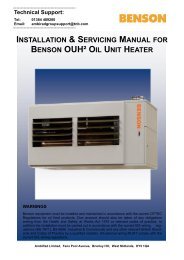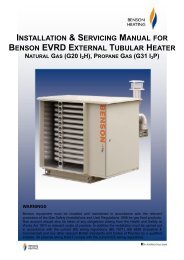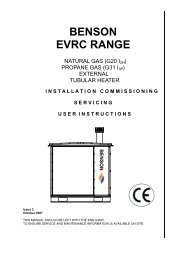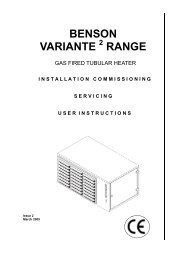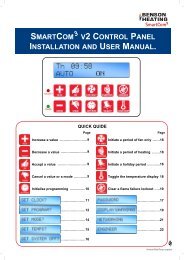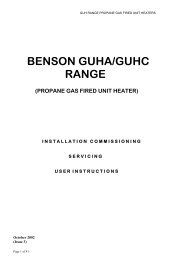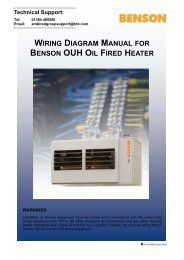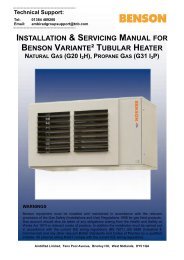INSTALLATION & SERVICING MANUAL BENSON PV TUBULAR CABINET HEATER
DONOTUSE Benson PV Range Mar2011 issue11 - AmbiRad
DONOTUSE Benson PV Range Mar2011 issue11 - AmbiRad
- No tags were found...
Create successful ePaper yourself
Turn your PDF publications into a flip-book with our unique Google optimized e-Paper software.
3.0 Commissioning<br />
Note<br />
It is a requirement that only suitably<br />
qualified and competent personnel are<br />
allowed to undertake the commissioning<br />
of the heater.<br />
It is also strongly recommended that prior<br />
to commissioning the engineers<br />
familiarise themselves with the heater. the<br />
specific requirements of the installation /<br />
application, and the information<br />
contained within the manual.<br />
Warning<br />
All heaters are subject to a rigorous test<br />
programme prior to despatch, whilst such a<br />
programme does involve pre-commissioning<br />
and the setting of the heater to operate<br />
efficiently and within its designed operational<br />
limits this does not mean that the function of<br />
thorough on site commissioning is less<br />
important<br />
It is strongly recommended that the<br />
equipment used for the sampling and<br />
analysis of the flue gases is accurate to<br />
within +/- 0.1% and maintained so that it is<br />
regularly calibrated.<br />
The following pre-commissioning checks<br />
should be undertaken, having first ensured<br />
that the gas and electrical supplies are<br />
turned off.<br />
(a) Check that all panels and fasteners are<br />
secure and in place.<br />
(b) Check that the heater is installed safely.<br />
(c) Check that the flue is sealed, secured,<br />
and adequately supported.<br />
(d) Check that the fan is free to rotate, that<br />
the fan is secured to its shaft, and that the<br />
guards and fan assembly are all in place and<br />
properly secured.<br />
(e) Check that the heater is installed so that<br />
it is not tilted and remains square.<br />
(f) Check that the outlet louvres are set to<br />
offer minimum resistance to air flow.<br />
3.1 Electrical pre-tests<br />
The electrical safety checks must include the<br />
following:<br />
a) Test for earth continuity<br />
b) Test for resistance to earth<br />
c) Check live and neutral connections are<br />
correct.<br />
d) Check to ensure that when the external<br />
controls operate to switch the heater off,<br />
power remains to the fan<br />
3.2 Gas supply pre-test<br />
Ensure that the service pipework has been<br />
installed purged and tested in accordance<br />
with the relevant regulations, and that the<br />
installation is served by an adjacent isolating<br />
cock.<br />
Connection from the supply to the heater<br />
must also comply with the relevant<br />
regulations (see section 8.0) and must have<br />
been purged and soundness tested by an<br />
authorised engineer<br />
3.3 Ignition sequence<br />
PRE START DRY RUN<br />
In order to test that all controls are in good<br />
working order, the control sequence should<br />
first be tested with the gas supply turned Off.<br />
Ensure gas isolating cock is in the Off<br />
position<br />
Warning<br />
If during the following sequence of<br />
operations the heater fails to operate<br />
correctly the fault should be traced and<br />
rectified before proceeding, if necessary<br />
referring to section 5.0 fault diagnosis.<br />
a) Switch off the main electrical supply to the<br />
heater.<br />
b) Turn off gas supply to the heater.<br />
c) Open side panel, and connect<br />
manometers to the gas supply test point and<br />
to the main burner test point.<br />
d) Ensure outlet louvres are correctly set.<br />
e) Ensure fan rotation is not impaired or<br />
obstructed.<br />
f) Set room thermostat to its lowest setting.<br />
g) If a time switch is fitted ensure it is set to<br />
an ON period.<br />
h) Switch on electrical supply.<br />
i) Use leak tester to test for soundness on<br />
the unions and pipework.<br />
j) Operate the heater through the installed<br />
control system.<br />
21



